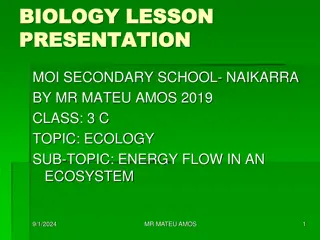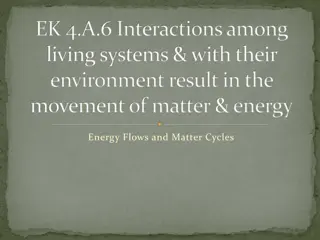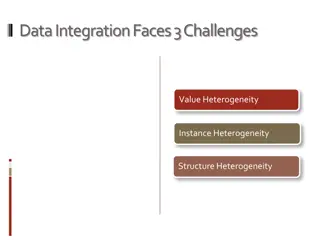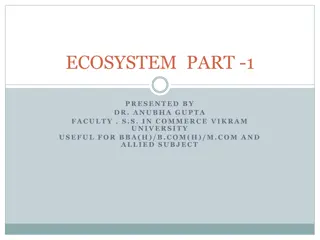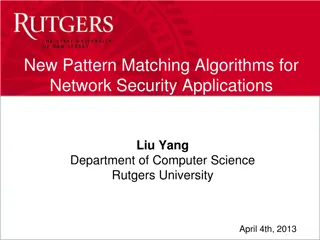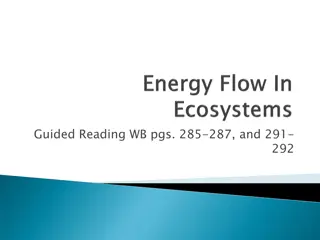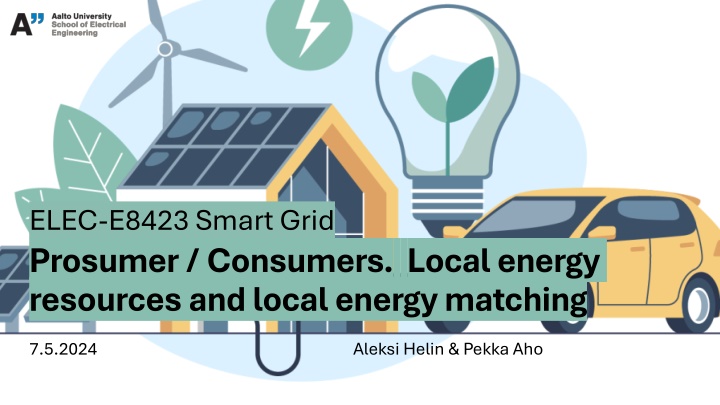
Local Energy Resources and Prosumer Benefits in Smart Grids
Discover the concept of prosumers in the smart grid context and the role of local energy resources in matching supply with demand. Explore the benefits of utilizing local energy sources, such as reducing peak demand and enhancing energy security, while understanding the challenges of local energy matching. Case studies and strategies for long-term energy storage and peer-to-peer trading are also discussed.
Uploaded on | 0 Views
Download Presentation

Please find below an Image/Link to download the presentation.
The content on the website is provided AS IS for your information and personal use only. It may not be sold, licensed, or shared on other websites without obtaining consent from the author. If you encounter any issues during the download, it is possible that the publisher has removed the file from their server.
You are allowed to download the files provided on this website for personal or commercial use, subject to the condition that they are used lawfully. All files are the property of their respective owners.
The content on the website is provided AS IS for your information and personal use only. It may not be sold, licensed, or shared on other websites without obtaining consent from the author.
E N D
Presentation Transcript
ELEC-E8423 Smart Grid Prosumer / Consumers. Local energy resources and local energy matching 7.5.2024 Aleksi Helin & Pekka Aho
Whatis a prosumer? Coined by Albin Toffler in 1980: Producer Producer- -Consumer Consumer Renewable energy source (RES) prosumers are individuals Renewable energy source (RES) prosumers are individuals or groups that both consume and produce RES or groups that both consume and produce RES- -based energy or offer energy services to the system, such as flexibility or or offer energy services to the system, such as flexibility or storage. storage. - - EEA EEA based energy
Theroleof a prosumer Allows anyone to participate in the clean energy transition. Cooperatives allow for participation with lower investment For example: Brooklyn Microgrid, Hvide Sande Fjevarme, Repowering London, and Magliano Alpi. Leading to environmental, financial, and social benefits.
LocalEnergy Resources Solar: Predictedto bethe lowest cost in comingyears Uses unutilisedspace Wind: Higher investment Requiresmorespace Pico/Micro hydropower: Relatively low investment, but can have auxiliary costs Limited by location
Benefitsof utilisingLocalEnergy Resources REDUCING PEAK DEMAND ENVIRONMENTAL SUSTAINABILITY DEFERRING INFASTRUCTURE UPGRADES REDUCED TRANSMISSION LOSSES CREATING LOCALJOBS INCREASED ENERGY SECURITY INCREASED CITIZEN ENGAGEMENT
LocalEnergy Matching Matching the energy production with local demand. Increasingly difficult with growing share of renewable energy. Essential for keeping grids stable, can lead to issues such as: Grid congestion, over- voltage, orunder-voltage.
Long-term energy storage Short-termenergy storage Smart grids and digitalisation LocalEnergy Matchingstrategies Peer-to-peerenergy trading Demand side flexibility
Brooklyn Microgrid (BGM) Community-driven initiativeestablished by LO3 Energy in 2016 Network connecting NYC residents and business owners Uses Exergy platform that utilizes blockchain and innovative solutions
HvideSandeFjernvacrme: consumer-owned districtheatingin Denmark Consumer owned company established in 1963, operates a district heating network along Danish west coast Operates through collective ownership and community engagement Sells generated electricity to the general electricity market, as well as buys from it Regulatory frameworks and customer participation offer challenges
Challenges and Opportunities Challenges Challenges Regulatory barriers Technical limitation Financial constraints Opportunities Opportunities Policy support Technological advancements Community engagement
Conclusions The role of consumers is evolving Prosumer cooperatives can have significant environmental, financial, and social benefits The utilization of local energy sources key benefits include Reduced transmission losses Reducing peak demand Citizen engagement in clean energy transition Increased energy security The transitions towards prosumerism has its challenges
References https://www.eesc.europa.eu/sites/default/files/resources/docs/draft_wg_report_consumers_market_agents_tc_110315_we b_version3.pdf EAA. (2022). Energy prosumers in Europe: Citizen participation in the energy transition. https://windexchange.energy.gov/small-wind-guidebook#practical https://www.helen.fi/en/solar-panels/own-solar-power-plant https://www.micro-hydro-power.com/planning-a-micro-hydropower-system/ https://www.iea.org/commentaries/empowering-people-the-role-of-local-energy-communities-in-clean-energy-transitions Energy prosumersin Europe https://www-sciencedirect-com.libproxy.aalto.fi/science/article/pii/S2666955221000551 - Local energymatching https://www.energymatching.eu/project/ https://www.brooklyn.energy/ Deane, J. P., & O Gallachoir, B. P. (2012). Assessing the impact of prosumerism on energy planning. Energy Policy, 51, 435- 444.





